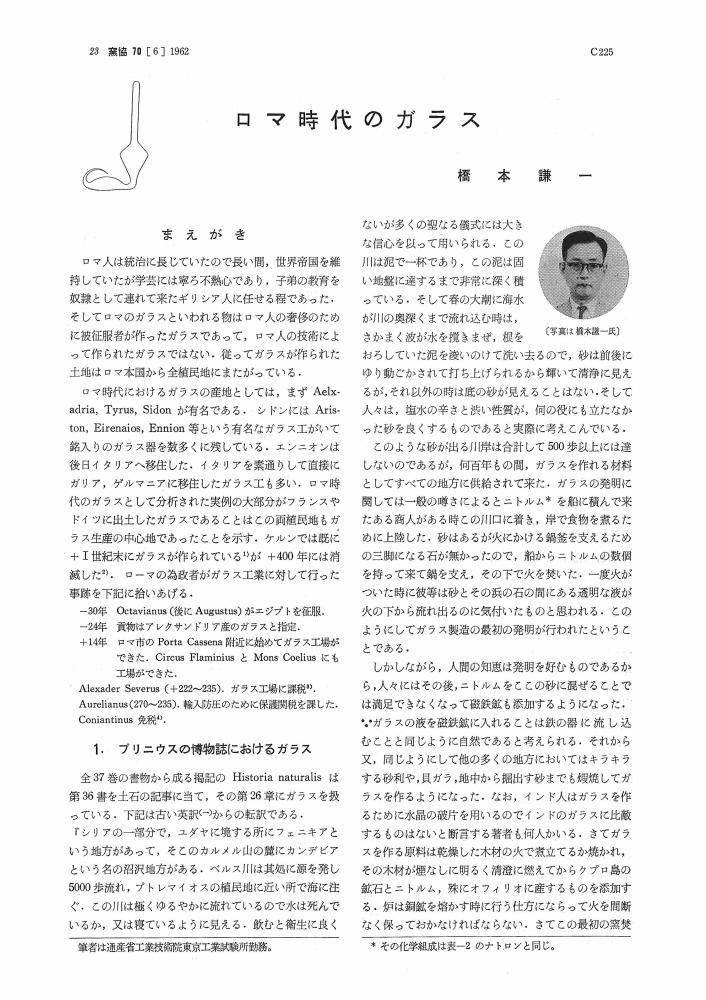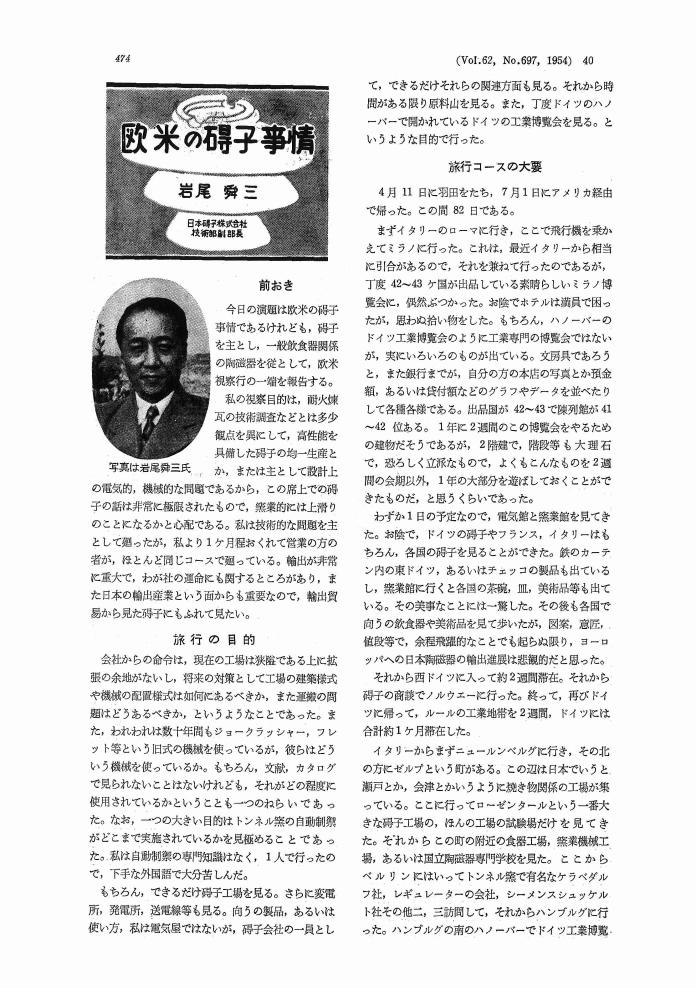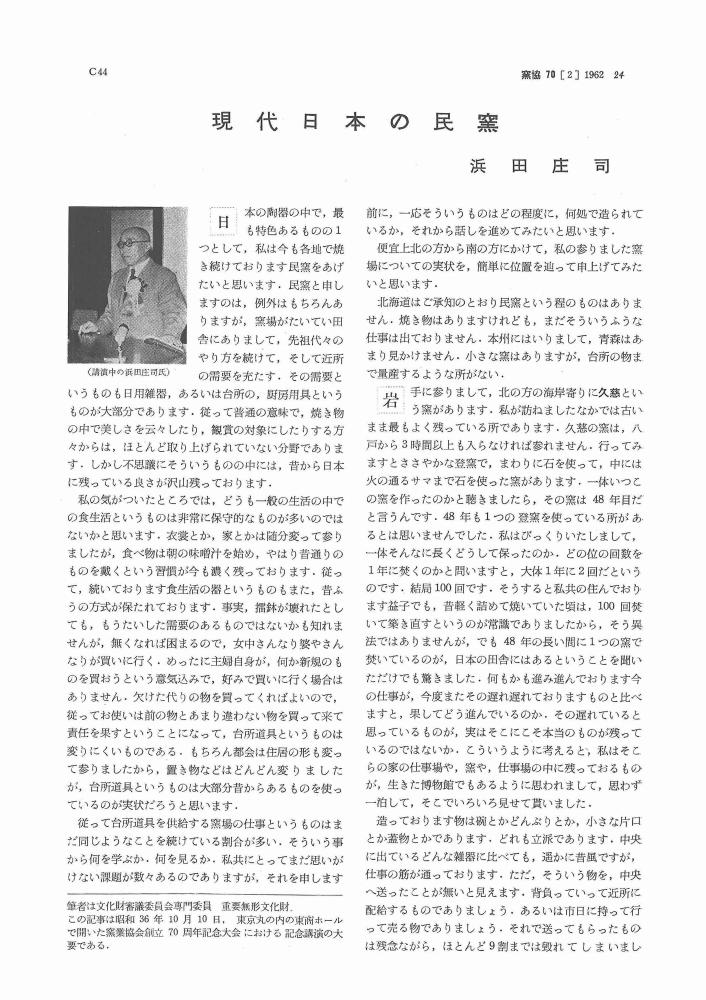12 0 0 0 OA ロマ時代のガラス
- 著者
- 橋本 謙一
- 出版者
- 公益社団法人 日本セラミックス協会
- 雑誌
- 窯業協會誌 (ISSN:00090255)
- 巻号頁・発行日
- vol.70, no.798, pp.C225-C233, 1962-06-01 (Released:2010-04-30)
- 参考文献数
- 53
6 0 0 0 OA 酸化マグネシウムと酢酸との反応
- 著者
- 石堂 善彦 藤井 欽二郎
- 出版者
- 公益社団法人 日本セラミックス協会
- 雑誌
- 窯業協會誌 (ISSN:00090255)
- 巻号頁・発行日
- vol.81, no.931, pp.115-117, 1973-03-01 (Released:2010-04-30)
- 参考文献数
- 5
Fused magnesia and magnesia clinker which were pulverized to such a fineness as shown in Table 1, were proven to react rather readily with glacial acetic acid at a temperature from 20° to 65°C. When the fractions of magnesia reacted were followed at each constant temperature by determining magnesium acetate formed in the reaction mixture which was soluble in methanol, the reactions proceeded after Jander's rate-equation except later reaction-stage as shown in Fig. 1 with an apparent activation energy of 21.8kcal/mol, though any diffusion layer didn't be observed around magnesia grains under microscope. In a semi-adiabatic condition, the temperature of the mixture should rise owing to the heat of reaction, resulting in acceleration of the rate of reaction more and more to cause the mixture to boil. These situations were examined at an initial temperature from 30° to 60°C. The results were shown in Fig. 3 in comparison with those obtained by numerical calculation using the rate data at constant temperatures and heat contents of the matters concerning to the reaction system.
3 0 0 0 OA 製鉄用耐火物に対するラジオアイソトープの応用
- 著者
- 飯島 弘 山口 哲夫
- 出版者
- 公益社団法人 日本セラミックス協会
- 雑誌
- 窯業協會誌 (ISSN:00090255)
- 巻号頁・発行日
- vol.67, no.764, pp.C259-C264, 1959-08-01 (Released:2010-04-30)
- 参考文献数
- 13
3 0 0 0 OA わが国における特殊ガラスの発達 (VI)
- 著者
- 会田 軍太夫
- 出版者
- 公益社団法人 日本セラミックス協会
- 雑誌
- 窯業協會誌 (ISSN:00090255)
- 巻号頁・発行日
- vol.64, no.724, pp.C243-C247, 1956-06-01 (Released:2010-04-30)
- 参考文献数
- 4
3 0 0 0 OA 酸化物強磁性体 主としてフェライトについて
- 著者
- 栗原 和信
- 出版者
- 公益社団法人 日本セラミックス協会
- 雑誌
- 窯業協會誌 (ISSN:00090255)
- 巻号頁・発行日
- vol.67, no.757, pp.C12-C20, 1959-01-01 (Released:2010-04-30)
- 参考文献数
- 35
- 被引用文献数
- 1 1
3 0 0 0 OA 原子力と窯業
- 著者
- 武田 栄一
- 出版者
- 公益社団法人 日本セラミックス協会
- 雑誌
- 窯業協會誌 (ISSN:00090255)
- 巻号頁・発行日
- vol.63, no.711, pp.392-396, 1955-07-15 (Released:2010-04-30)
2 0 0 0 OA 欧米の碍子事情
- 著者
- 岩尾 舜三
- 出版者
- 公益社団法人 日本セラミックス協会
- 雑誌
- 窯業協會誌 (ISSN:00090255)
- 巻号頁・発行日
- vol.62, no.697, pp.474-479, 1954-07-01 (Released:2010-04-30)
2 0 0 0 OA 現代日本の民窯
- 著者
- 浜田 庄司
- 出版者
- 公益社団法人 日本セラミックス協会
- 雑誌
- 窯業協會誌 (ISSN:00090255)
- 巻号頁・発行日
- vol.70, no.794, pp.C44-C51, 1962-02-01 (Released:2010-04-30)
2 0 0 0 OA セラミック外論 (1)
- 著者
- 素木 洋一
- 出版者
- 公益社団法人 日本セラミックス協会
- 雑誌
- 窯業協會誌 (ISSN:00090255)
- 巻号頁・発行日
- vol.68, no.773, pp.C160-C165, 1960-05-01 (Released:2010-04-30)
2 0 0 0 OA 陶磁器顔料
- 著者
- 加藤 悦三
- 出版者
- 公益社団法人 日本セラミックス協会
- 雑誌
- 窯業協會誌 (ISSN:00090255)
- 巻号頁・発行日
- vol.66, no.746, pp.C63-C67, 1958-02-01 (Released:2010-04-30)
1 0 0 0 OA 衛生陶器の現状と将来
- 著者
- 江副 勇馬
- 出版者
- 公益社団法人 日本セラミックス協会
- 雑誌
- 窯業協會誌 (ISSN:00090255)
- 巻号頁・発行日
- vol.73, no.840, pp.C464-C471, 1965-08-01 (Released:2010-04-30)
1 0 0 0 OA CaO-Al2O3-SO3系仮焼粉末による水溶液中のウランの回収
- 著者
- 牧 俊夫 矢野 正行
- 出版者
- 公益社団法人 日本セラミックス協会
- 雑誌
- 窯業協會誌 (ISSN:00090255)
- 巻号頁・発行日
- vol.89, no.1035, pp.585-594, 1981-11-01 (Released:2010-04-30)
- 参考文献数
- 22
- 被引用文献数
- 1 1
硫酸アルミニウムと塩化アルミニウムの水溶液及び消石灰乳液を種々の割合に混合することによって, 主にエットリンジャイト (6CaO・Al2O3・3SO3・32H2O) からなる白色のケーキを作製した. 次にそのケーキを500℃及び600℃で仮焼し, 粉砕して80-200メッシュの粒度をもつ試料を調製した. 2.9CaO・Al2O3l・4SO3または2.5CaO・Al2O3・1.2SO3の酸化物組成をもつ仮焼粉末は, 粒子強度とウランに対する捕集速度がかなり大きかった. すなわち U(VI) イオンの100ppmを主に[UO2(CO3)3]4-の形で含むアルカリ水溶液の50ml中に, それらの粉末の0.100gを2時間浸漬したとき, それらの試料は溶液中に存在するU(VI) イオンの80-100%を捕集した. 捕集したウランは60℃に保った5% NaHCO3溶液中に試料を1時間浸漬する方法で脱着させることができる.捕集前後の上記粉末のX線回折分析及び試料粉末を浸漬したときに起こる純水及び吸着液のpHの変化から, 本試料によるウランの捕集は, 試料の加水分解により生成するCa(OH)2と吸着液中の[UO2(CO3)3]4-イオンが反応して試料表面に二ウラン酸カルシウム (CaU2O7) が生成するために起こること, また脱着はCaU2O7と上記NaHCO3溶液が反応してU(VI) がもとの[UO2(CO3)3]4-イオンに戻るために起こることを明らかにした.
1 0 0 0 OA 風化花崗岩に含まれる粘土とその窯業原料としての利用
- 著者
- 陣内 和彦
- 出版者
- 公益社団法人 日本セラミックス協会
- 雑誌
- 窯業協會誌 (ISSN:00090255)
- 巻号頁・発行日
- vol.82, no.948, pp.454-461, 1974-08-01 (Released:2010-04-30)
- 参考文献数
- 10
- 被引用文献数
- 1
Recently, big increase of ceramic product has brought the great consumption of its materials. The author has tried to obtain the ceramic clay from the weathered granitic rocks. At first the forming process and containing situation of clay minerals were surveyed on various rocks at each step of weathering, and then the selection of suitable raw material and extracting method of ceramic clay were investigated.The results of this study are summarized as follows:(1) Among the constituent minerals of granitic rocks, plagioclase and biotite are altered most easily by weathering and kaoline, gibbsite, vermiculite etc. are formed and contained in the weathered rocks.(2) Kaoline is contained in all kinds of weathered and decomposed granitic rocks, even in the rather coarse size range of about 100-150micron.(3) The clay from so called “masatsuchi” can be used as a material of ceramics. Especially, the extremely weathered but not contaminated one provides the clay of higher grade in good yield.(4) In order to get the clay of high quality from the weathered granitic rocks, raw material should be scrubbed softly in water, and the cut size of clay should be as fine as possible. And clay can be made higher grade through magnetic separation.
1 0 0 0 OA 化學磁器と耐火煉瓦の搖籃期を語る
- 著者
- 新村 信太郎 河島 千尋 稻生 謙次
- 出版者
- 公益社団法人 日本セラミックス協会
- 雑誌
- 窯業協會誌 (ISSN:00090255)
- 巻号頁・発行日
- vol.59, no.659, pp.221-224, 1951-05-01 (Released:2010-04-30)
1 0 0 0 OA 本邦における高アルミナ質耐火煉瓦製造技術の変遷
- 著者
- 浮洲 武彦
- 出版者
- 公益社団法人 日本セラミックス協会
- 雑誌
- 窯業協會誌 (ISSN:00090255)
- 巻号頁・発行日
- vol.66, no.753, pp.C347-C350, 1958-09-01 (Released:2010-04-30)
1 0 0 0 OA ガラスの放射線着色に対するセリウムの着色防止機構について
- 著者
- 曽我 直弘 田代 仁
- 出版者
- 公益社団法人 日本セラミックス協会
- 雑誌
- 窯業協會誌 (ISSN:00090255)
- 巻号頁・発行日
- vol.70, no.797, pp.143-147, 1962-05-01 (Released:2010-04-30)
- 参考文献数
- 15
- 被引用文献数
- 7 7
Glasses containing various amount of trivalent cerium ion (20K2O, 10BaO, 70SiO2, 0.1CeO2, and 0-0.2 Si (mole %)) were first exposed to γ-radiation until they were colored to the same degree, and then, the fading of their color occured with the lapse of time was measured. The content of Ce3+ ion in these glasses was also measured by the spectrophotometric method in order to obtain a relation between its content in the glasses and the fading velocity of their γ-ray induced color. The result showed that the higher the content of Ce3+ ion in the glass is, the higher the fading velocity of its color is.On the basis of this result and the results of the spectrophotometric studies on the cerium-containing glasses so far made by the authors (J. Ceram. Assoc. Japan, 68, 132; 169 (1960)), the authors gave their view on the role of Ce3+ ion in preventing the γ-ray induced coloration of glass: Being excited by γ-ray irradiation, oxygen ions in glass loose some of their electrons. The Ce3+ ions give their weak-bonded 4 f-electrons to the oxygen ions, thus preventing the formation of V-center like defects in glass. At the same time, the Ce3+ ions, now holding positive holes as the result of their lending their 4 f-electrons to the oxygens, catch the ionized electrons that would be trapped or were already trapped by oxygen ion vacancies, thus preventing the formation of F-center like defects in glass. The total function of the Ce3+ ion in glass under γ-ray irradiation is, therefore, the recombination of the positive holes and the ionized electrons, thus preventing the formation of color centers.
1 0 0 0 OA セラミック原料解説集 キ
- 著者
- 浜野 健也 大野 正夫 素木 洋一 宇田川 重和 加藤 悦三 岡崎 清
- 出版者
- 公益社団法人 日本セラミックス協会
- 雑誌
- 窯業協會誌 (ISSN:00090255)
- 巻号頁・発行日
- vol.73, no.835, pp.C156-C161, 1965-03-25 (Released:2010-04-30)
1 0 0 0 OA 日展の陶磁器を見て
- 著者
- 佐藤 潤四郎
- 出版者
- 公益社団法人 日本セラミックス協会
- 雑誌
- 窯業協會誌 (ISSN:00090255)
- 巻号頁・発行日
- vol.70, no.793, pp.C26, 1962-01-01 (Released:2010-04-30)
1 0 0 0 OA 水甕から杯まで
- 著者
- 佐藤 潤四郎
- 出版者
- 公益社団法人 日本セラミックス協会
- 雑誌
- 窯業協會誌 (ISSN:00090255)
- 巻号頁・発行日
- vol.63, no.704, pp.39-42, 1955-01-01 (Released:2010-04-30)
- 参考文献数
- 16
1 0 0 0 OA セラミック外論 (30)
- 著者
- 素木 洋一
- 出版者
- 公益社団法人 日本セラミックス協会
- 雑誌
- 窯業協會誌 (ISSN:00090255)
- 巻号頁・発行日
- vol.70, no.803, pp.C485-C496, 1962-11-01 (Released:2010-04-30)















